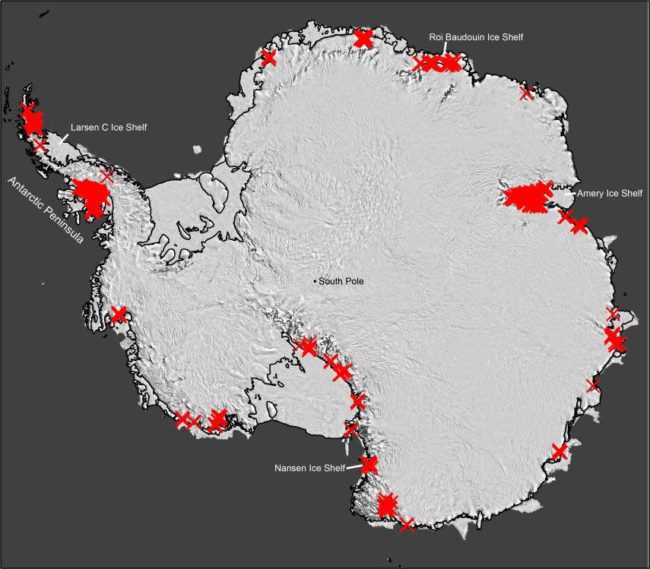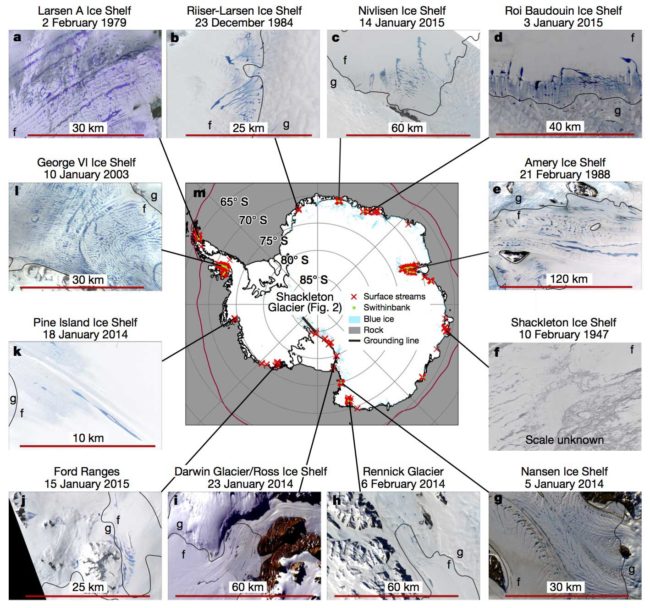
A new study reveals a rather extensive system of meltwater is flowing within the Antarctic.
Entitled “Widespread movement of meltwater onto and across Antarctic ice shelves“, it was published in Nature a couple of days ago. The title is not simply a hint, but describes exactly what this study reveals.
Up until now the very existence of such a system of meltwater drainage was thought to be rare. The key to understanding why this is an important discovery is to perhaps appreciate that the very presence of such large-scale drainage systems is one of the key factors that needs to be considered when modelling ice-sheet stability. This is a point that they make within the paper itself …
Improving the representation of ice-sheet surface hydrology in climate and ice-sheet models will be vital for improving predictions of ice-sheet mass balance and sea-level rise.
The study itself is unique. Nobody had done such an extensive survey before and so something not previously realised or appreciated has now emerged. Previously specific examples of meltwater have of course been documented, but not on continent-wide scale.
So how did they do this survey?
They used Landsat images (that date from 1973 onwards), and also aerial photography (1947 onwards) to review what has been happening for many decades.
Comments
Lead author Jonathan Kingslake, a glaciologist at Columbia University’s Lamont-Doherty Earth Observatory explains …
“This is not in the future—this is widespread now, and has been for decades, I think most polar scientists have considered water moving across the surface of Antarctica to be extremely rare. But we found a lot of it, over very large areas.”
Commenting further on one interesting question – has the extent or number of drainages increased over the seven decades covered by the study? – he says …
“We have no reason to think they have, But without further work, we can’t tell. Now, looking forward, it will be really important to work out how these systems will change in response to warming, and how this will affect the ice sheets.”
Coauthor Robin Bell, also a Lamont-Doherty polar scientist, also muses over this and suggests …
“This study tells us there’s already a lot more melting going on than we thought, When you turn up the temperature, it’s only going to increase.”
Helen Fricker, a glaciologist at Scripps Institution of Oceanography who was not involved the new studies, said of the continent-wide survey …
“We knew there were other [melt] zones, but we didn’t know exactly how extensive they are. This is a really nice study, as it does just that.”
Douglas MacAyeal, a glaciologist at the University of Chicago also not involved in the studies, said that until recently,
“nobody’s been that interested in melting,” because most scientists thought it was relatively rare. Now, he said, “We’re working hard to figure out if this stuff is relevant to sea-level predictions.”
Should we be concerned?
Greenland does give us a clear illustration of the potential importance and impact of meltwater.
Historically the primary contribution that Greenland made to water discharge was via iceberg discharged from glaciers. That however has recently changed. Between 2011 and 2014, 70 percent of the 269 million tons of Greenland’s ice and snow lost to the ocean came directly from meltwater, not icebergs.
A Meltwater Illustration
Via Climate Central who discuss this finding, here is a clip of Meltwater that illustrates what this is all about.
What you can see below is a very short video captured from an aircraft. It is of a 400-foot-wide waterfall that drains off the Nansen Ice Shelf into the ocean. (Wong Sang Lee/Korea Polar Research Institute).
